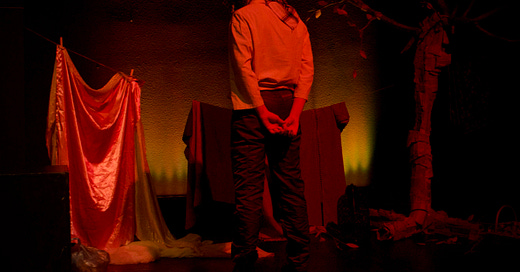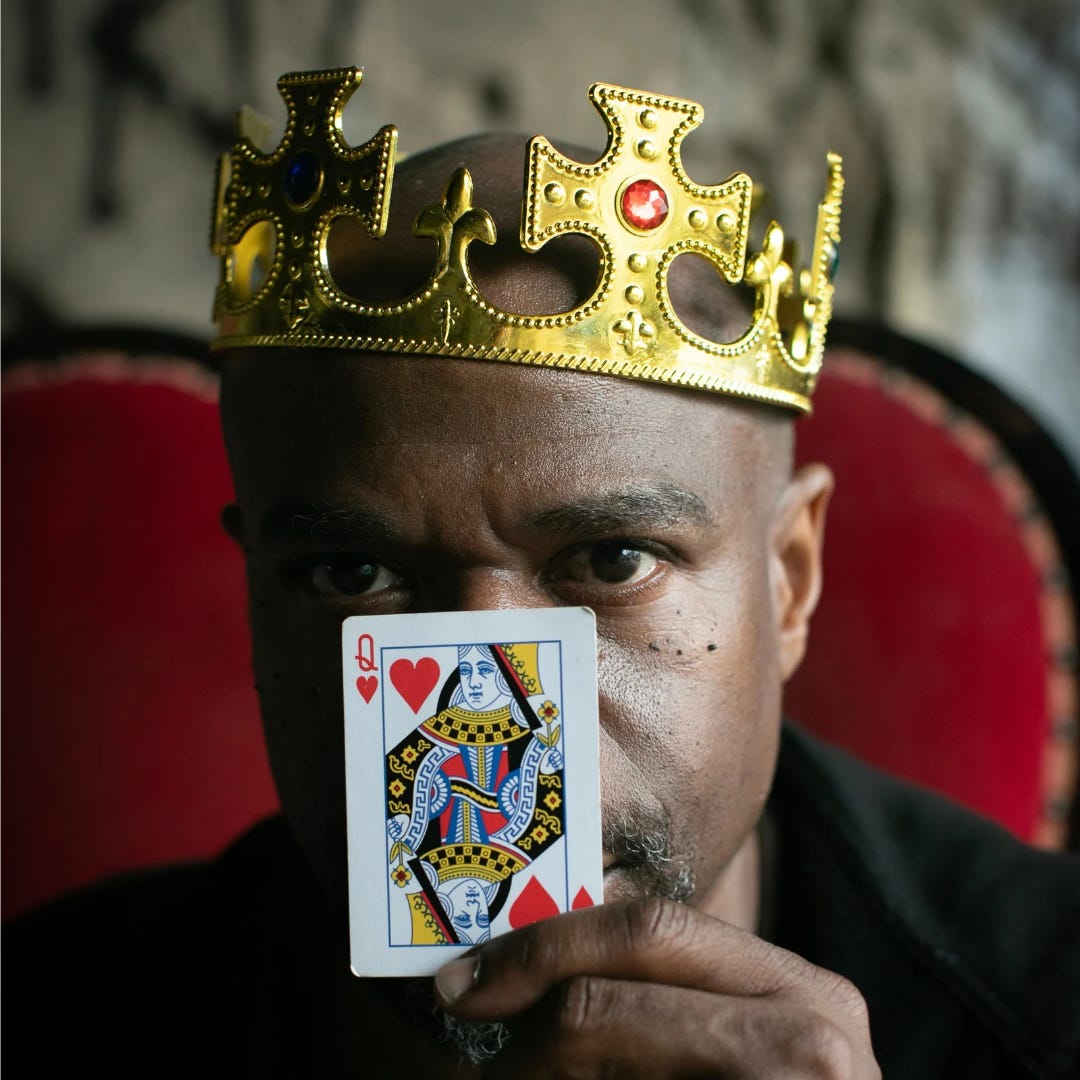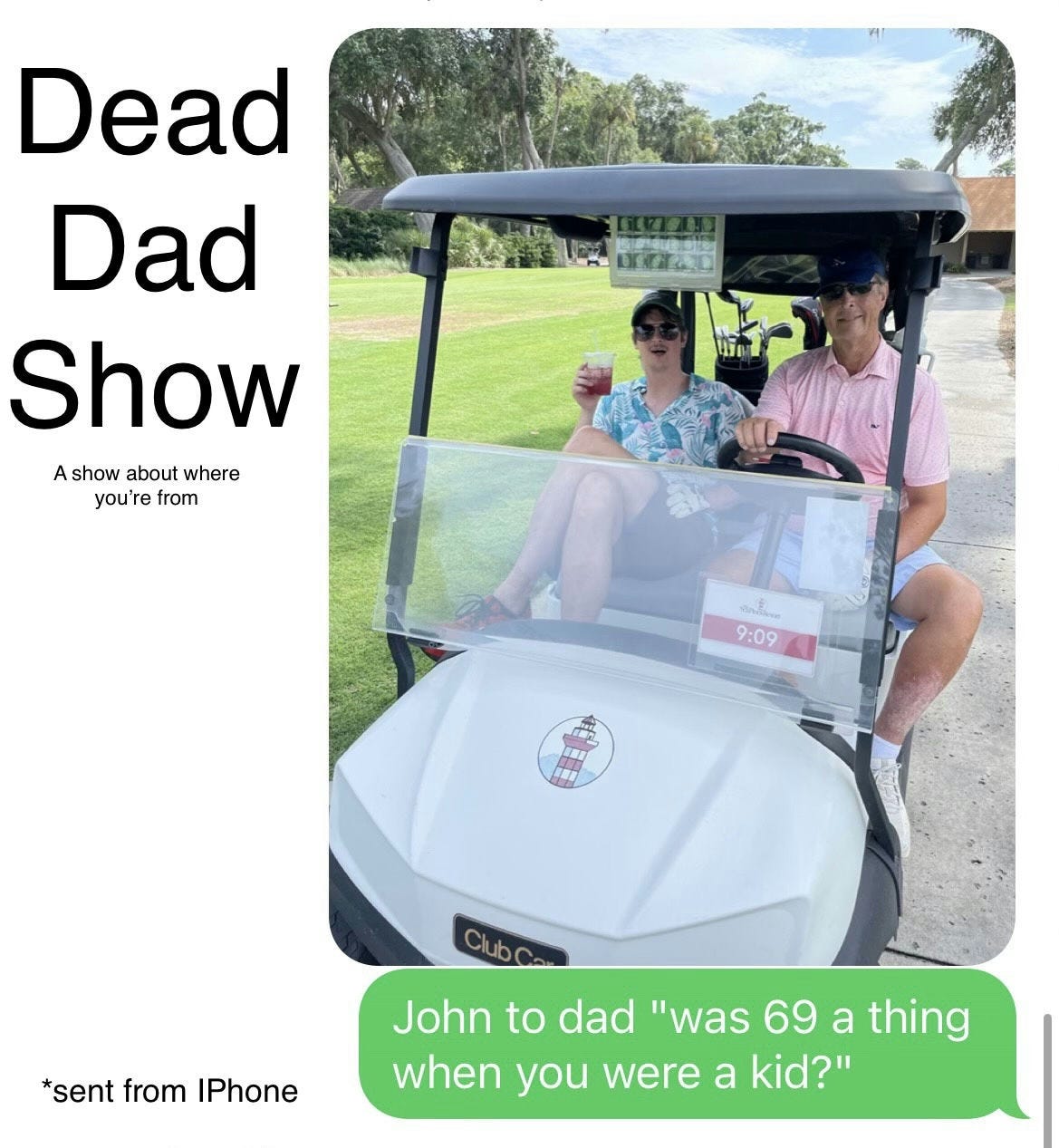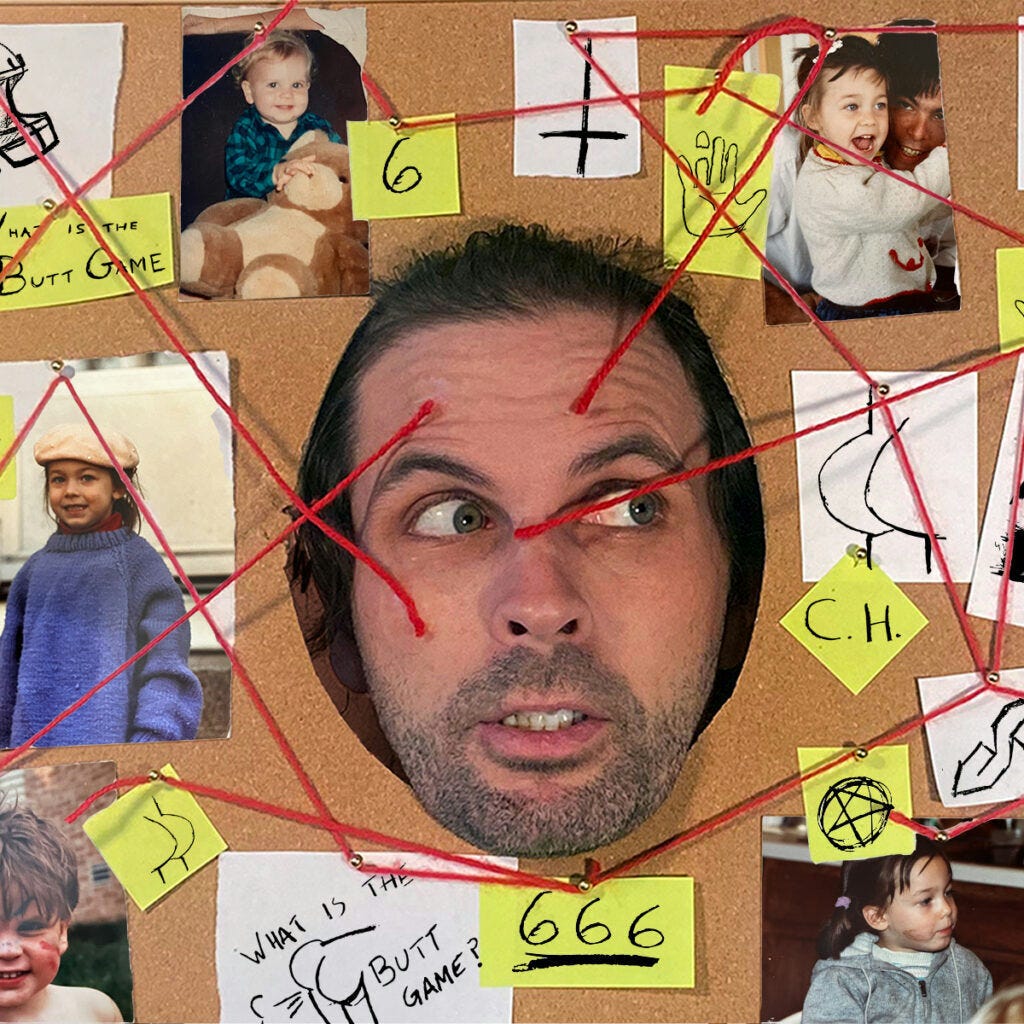Handala, An Avalanche of "No," Suddenly Last Summer, and more
Reviews of five Philly Fringe shows, including New Paradise Labs and Die-Cast, Savannah Reich's What is the Butt Game?, and John Miller Giltner's Dead Dad Show
Handala
by Myriam Ali-Ahmad
directed by Becca Khalil and Mahmoud AboBaker
Continuing on September 19 at Icebox Project Space, and on October 11 as part of United Solo in New York
Highly recommended
A tour de force, Myriam Ali-Ahmad is a major talent.
Handala weaves together the verbatim account of a former Israeli Defense Forces soldier with narratives and stories composed from interviews with Palestinians and three Palestinians poems, including the now famous “If I Must Die” by Dr. Refaat Alareer, poet and Shakespeare scholar,1 who was assassinated last December by the Israeli Defense Force. There’s an old woman who remembers her home before she had to flee it, and goes to visit it. There’s someone climbing a wall, striving for freedom. Someone wakes up to the smell of smoke and burning. These narratives intersect. The soldier puts the wall-climber in his sights, but he makes eye contact, and his whole world collapses.
Ali-Ahmad delivers a powerhouse performance, giving each of her characters a distinct physicality and voice, from the nervous patrolling soldier, to a bouncy child, to their caregiver, to an elderly woman with a cane, and to the cartoon Handala, the 10 year old boy dreamed up by Naji al-Ali, who has become a symbol of Palestinian resistance.
Handala not only tells Palestinian stories of survival, resistance, and hope, but also shows the psychic horror of the indoctrination required to dehumanize an entire people. It describes the beauty of the land, as in a gorgeous passage about Al-Aqsa and the Dome of the Rock. It speaks of the souls of the olive trees, and how the settlers burn them. It imagines a free Palestine. In a moving scene, a man is surprised to take his family on a drive and to make it in good time, no longer met by checkpoint after checkpoint which currently deny Palestinians the most basic of rights, freedom of movement. Braiding these threads tightly together creates a rich tapestry of Palestinian life and feeling which, when it’s allowed to, bubbles over with joy.
The set by Lou Hemler, anchored by a stool in the center, a bare tree up right, a clothesline, and a wall of boxes and crates, is simple, effective, and evocative, providing places to store props and costumes where they blend into the backdrop, as well as a wall to eventually bring down. If there’s a weak point here, it’s largely from the acoustic limitations of the echo-prone Icebox Project Space, and in some of the projected video used during scenic transitions. The live score by Mostafa Darwish and Rayhan Blankinship, and sound design by Gracie Martin, add depth and texture that elevate the work.
This is theater at it’s most vital, most humanitarian, and most urgent. Handala is also a fundraiser, with proceeds going to a family in Gaza in need of medical evacuation.
An Avalanche of “No”
by Jeffrey Cousar
with New Paradise Laboratories
direction and additional text by Whit MacLaughlin
Continuing September 18 at Christ Church Neighborhood House
Recommended
Jeffrey Cousar saw Andre Braugher play Macbeth in 1993, instilling in him a lifelong ambition to play the part. Cousar tells us his story. 33 years of not getting that role, of the roles life has cast him in: getting fired from an early acting job, getting racially profiled in Europe while touring as a dancer, troubles in love and marriage, and the difficulties, humiliations, and amusing anecdotes of having a day job as a night porter. This is theatrical autobiography, setting his performance career into the context of the specificities of a life. These are the material conditions that shape what opportunities and chances we get, the leg-ups afforded by class and race and background, down to the little things like rehearsal room etiquette.
This is deeply vulnerable stuff, including the heart attack he suffered during the development of An Avalanche, and I’m grateful to Cousar for sharing it. It’s his vulnerability, the disclosure of so many failures and fraught moments, from getting scammed at three card monte, to custody battles and having to get creative to keep his house, that make the show work. The at-times clever staging helps, too, especially lively when he hops on his skateboard or plays records (Cousar was a DJ, he tells us), and when he produces a sword somehow hidden behind the throne that anchors the stage, center. He riffs on Macbeth, on his own life. Shakespeare riffed, he says, “Riffing can be another sort of true.”
My interest waxed and waned through some of his tales, and part of me kept thinking, as Cousar weaves in and out of Macbeth, well, yeah, I see why he never got that part. But the play isn't really about that. It’s not about an individual casting choice. By the time he reaches, “Tomorrow, and tomorrow, and tomorrow,” it's about all the little indignities and major failures of life, of the odds against the dreams of a working class black man, and he cracks that brief monologue wide open. Macbeth at his lowest, Shakespeare at his darkest, and Cousar, beaten down, claims this as his victory. Afropessimist indeed.
John Miller Giltner’s Dead Dad Show
directed by Sasha Kostyrko
Continuing September 21, 22, 26, 28, and 29 at the Christ Church Neighborhood House
Not recommended, with redeeming qualities
I don't know how to write about this show. In part because it's not the kind of thing I typically write about. In part because, when I saw it at least, it was self-consciously unfinished, and also because it's self-consciously concerned with getting a good review.2
This is more alt-comedy than theater, much of it told via PowerPoints and videos, and it runs shy of an hour. It's often fun, but also very clearly a work-in-progress. This is the kind of thing that would be better in a bar, with Giltner telling us part of his plan was to sell us $4 White Claws (one of the downsides to the Cannonball mask policy is that the audience can't drink, a thing audiences often like to do).
I was charmed by the casualness with which Giltner welcomed everyone into the small room at the Neighborhood House, which they wanted to “feel like [their] bedroom.” The intimacy of the room helps. Giltner is affable and likable. They’re dressed equally casually, with Nike shorts and a university of Kentucky hoodie (they started to complain about the heat pretty quickly). There’s a metatheater to some of this casualness that I liked, at first, but started to feel like unpreparedness, as if Giltner was groping their way through the various browser tabs open on his laptop, projected behind them, instead of moving through the tabs in a planned way. Giltner set out two goals for the show: to think about grief, and to get laid. They play Uncle Kracker for us, because his dad would, and they recite Wendell Berry.
Some of the bits are pretty good and funny, while others feel like raw material. Giltner seems to not know what to do with some of it, especially the stuff about their dad being an evil corporate banker and their ancestors’ troubling slaveholding history. Other material borders on being, or is, too niche. I don’t know why we were shown a YouTube video for “My Old Kentucky Home.” If all of this is meant to form a structure for Giltner to improvise within, it needed more work and tightening up, and not only with some technical bits. Some of this tightening is sure to come over the rest of the run, but I don’t think there’s an hour of material here yet.
Grief is a perennial favorite topic for solo shows. Giltner’s slide about this, images of other white guys’ Dead Dad Shows, is one of the stronger moments in the show, but their own Dead Dad Show doesn’t go on to make a strong case for itself. As a show about grief, loss, and mourning, I don’t think this is successful. When I saw it was more like an artifact, maybe, of Giltner’s grief, showing us how fucked up they’ve been and how it continues to impact them. But the show is also a kind of memorial for Giltner’s dad, and that’s something on which its success I cannot judge.
Suddenly Last Summer
by Tennessee Williams
directed by Brenna Geffers
Sept 14 and 15 at Plays and Players, next at the Provincetown Tennessee Williams Theater Festival, September 27 through 29
Recommended
Die-Cast’s production of Suddenly Last Summer emphasizes Williams’ lyricism with bold performances and a propulsive live score under Geffers’ able direction.

A tense, southern gothic tale, Suddenly Last Summer pits Mrs. Venable (Colleen Corcoran), the mother of a dead poet against her niece Catherine (Han Van Sciver). The aging Mrs. Venable is seeking a change in psychiatric care for Catherine, in the form of a transfer to Dr. Cukrowicz, aka Dr. Sugar (Griffin Stanton-Ameisen), a specialist in lobotomies.
Geffers stages the play on the Plays and Players mainstage, with the audience sat upstage and facing out into the theater. The stage is a tight, intimate playing space, and the house becomes a backdrop, the garden outside the room where the play takes place, where performers may move and occasionally look in from at a remove, as if from the windows.
Van Scriver is excellent here, as is Ross Beschler who delivers the stage directions and haunts the play as the deceased Sebastian Venable. This is a marvelous touch, not only giving us Williams’ deeply poetic stage directions, especially those that describe the jungle-like garden, but also directly connecting playwright to character. If the first scene of the play lags—after Beschler sets the scene—when the details of Dr. Sugar’s profession as a lobotomist are revealed, the menace of the play snaps into focus.
I have one quibble, that when Catherine is finally telling us what happened leading up to Sebastian’s death, which is in turn acted out by Beschler (joined by others), it begins to distract from Van Scriver’s performance. Enacting this, with lurid detail, I think exchanges some of the lyricism of the text and its impact on the other actors in the scene for impact directly on the audience through the action; exchanging the figurative for the literal. When Catherine’s speech is over, before Mrs. Veneble finally responds, I could have forgotten she was there.
As Mrs. Veneble, Corcoran is a touch over the top. Holding the family money over the heads of her in-laws, and promising a significant donation to Dr. Sugar’s cause, she yields most of the power in this scenario. When provoked, she gets loud. But when you hold the cards, there's no need to yell. Joyous Whitfield, Steven Wright, Kishia Nixon, and Anthony Crosby ably round out the cast, though some of the smaller roles seem less fully formed.
Chris Sannino’s live score, joined at times by Van Scriver on percussion, keeps the energy of the show propulsive and appropriately underscored, even providing a very clean ending to the show. The show’s earlier moments feature some quite a bit of shared line deliveries; choral work is a Die-Cast signature. Costumes by doug greene are straightforward, putting everyone but Beschler in black, with just enough little touches to add character.
This is deeply personal stuff for Williams, whose older sister was lobotomized. This is a battle of family money and respectable society against the queer, the difficult, and the perverse; Sebastian—and Williams—a contradiction that straddles them both.
What is the Butt Game?
by Savannah Reich & Connor Hogan
Continuing on September 20 and 26 at Christ Church Neighborhood House
Not recommended, with redeeming qualities
Playwright Savannah Reich has been exploring what’s possible within the Fringe festival format for years, looking at ways of making theater that get around the constraints of a traditional rehearsal process (time, money, etc) and for touring. I’m very glad to see artists doing that, as the solo seems to be ever more dominant, especially since 2020. One of these explorations was her entry into last year’s Fringe, Tristan Tzara Was My Best Friend in Junior High, a charming, immersive dinner party of a play that she had first toured years earlier. Another was her 2022 Fringie winner, Oedipus in Seattle, which I didn’t see, and which used a rotating cast of unrehearsed actors who took instructions on headsets to perform a mashup of Oedipus Rex and Sleepless in Seattle.
For What is the Butt Game?, Reich has teamed up with Connor Hogan, who directs and performs, as Reich (Reich herself also performs), and is again working with unrehearsed actors taking instructions on headsets. In Butt Game, three unrehearsed performers, rotating each performance (Rose Luardo, Brooke Shilling, and Rebecca Posner when I saw it, the rotation is also a clever way to attract more crowds), also take direction live from Hogan (as Reich).
The content of Butt Game concerns the daycare that Reich attended as a child, which was shut down after its operator, Lynne, was accused of Satanic panic-related neglect and abuse. The first part of the show has good bits about the Satanic panic. The show’s latter part stages the investigation into Lynne’s daycare, though it doesn't present much of a case that this was due to the fears around Satanism that roiled middle America in the 80s, so much as more routine concerns rooted in run-of-the-mill reaction. Nevertheless, the Satanic panic is rich theatrical material, and provides a cultural backdrop.
Butt Game works best when the three unrehearsed actors are improvising, doing their take on whatever Hogan has instructed them to do, be it to explain the Satanic panic to the audience, play a version of a butt game, or perform an action which Hogan then recontextualizes to comic effect by narrating it as something different (gutting a pig? That's a satanic ritual). Like classic improv games dropped into a new, way weirder context. There are moments when this approaches an integration of content and form, as if these unrehearsed actors have been put in daycare under the supervision of Reich and Hogan, and by proxy, Lynne.
The headset material dominates the latter half of the show, and none of it worked for me. I'm very interested in the possibilities of feeding people lines. It's a technique I've used in rehearsal. I admire how The Wooster Group uses audio recordings for a mimetic technique.3 A rehearsal process is often largely about trying to recreate the spontaneity of a first encounter with a text, and I've thought a lot about potential ways to use recordings to skip ahead in rehearsals and change the math on doing shows. Which is to say, I think I get what Reich and Hogan are going for, at least part of it.
I was lost as to why performers were doubled when taking their lines from headsets: Reich and one of the unrehearsed would be speaking as one person, while the other two unrehearsed would be the scene partner. Coming off like poor choral work, they became presentational scenes about the reading of lines, rather than a way of letting the actors play the scene together, experiencing these lines for the first time. The headset material doesn’t pay off the way improviser daycare does.
I admire the risks taken here. But I don’t think this is a play. There are ideas; but it’s more like an experiment, or a draft, and one in need of a director and more development—which isn’t surprising, this is a very difficult kind of show to make. In its current state, I’d rather be in it than watching.
A couple additional festival picks:
Piip and Tuut at Concert September 20 to 26. Piip and Tuut are Estonian clowns who have been working together as a duo since 1998—they must be doing something right. Shows this weekend are at Liberty Lands, and next week they’re at Christ Church Neighborhood House.
Donna Oblongata brings her Van Gogh Shogh to The Deep End Studios September 24 and 25.
A posthumous collection of Dr. Alareer’s poetry and writing is forthcoming soon, and is available for pre-order.
Sorry, John.
Integration of new media technologies with live performance is/was a key research of area of mine when I was/am flirting with the academy).








